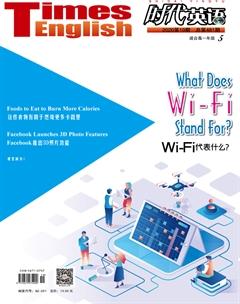地球里面
V. M. 希利尔 汤敏
V.M.希利爾(1875—1931),美国著名的儿童教育家、科普作家,创建了卡尔弗特教育体系。他为孩子们编写了一套趣味盎然的历史、地理、艺术读物,即《写给孩子看的世界历史》《写给孩子看的世界地理》《写给孩子看的艺术史》。本文选自《写给孩子看的世界地理》。
When I was a very little boy I was very inquisitive. At least, thats what my nurse called me.
One day when I was walking with her along the city pavements, I asked:
“Jane, whats under the pavement?”
“Oh, just dirt,” she replied.
“And what is under the dirt?”
“Oh, more dirt,” she replied.
“Well, whats under that?” I asked. I wasnt satisfied.
“Oh, nothing—I dont know—why are you always so inquisitive?” she asked.
I knew there must be something underneath that, and I just wanted to know what it was—I was just inquisitive.
I had heard that the place bad boys went to when they died was down under the ground somewhere—a big cave, perhaps—and I wanted to know if that was so.
So I made up my mind Id dig down through the World; down, down, down, till I came through on the other side,and then Id know. I was a very little boy, you see. With a tin shovel I started a hole in the back yard behind the grapevines, where no one would know what I was doing. I wanted to keep it a secret until I had dug all the way through. Day after day I worked, digging up first soft ground—that was easy—then I got down to solid ground; that was hard. I had a hole which I could stand in up to my waist.
当我还是一个很小的小男孩的时候,我就是个好奇宝宝。至少,我的保姆是这么叫我的。
有一天,我们沿着城市的人行道散步的时候,我突然问她:“简,人行道的下面是什么呀?”
她回答我:“噢,只是泥土。”
我接着问:“那泥土下面是什么呢?”
她回答说:“噢,更多的泥土。”
显然我对这个答案并不满意,所以我接着问:“可是那下面是什么呢?”
但她只是说:“哦,什么也没有——我不知道——你为什么总是这么好奇?”
我知道在泥土下面肯定还有什么东西,我想知道那下面到底还有什么——仅仅只是因为好奇。
我以前听说过,地底下是坏孩子死后会去的地方——也许是一个巨大的洞穴吧。我很想知道这是不是真的。
所以我决定,要挖一条穿过地球的通道去看个究竟。我只要不停地挖呀挖,等挖到地球的另一边,我就会知道了。要知道,我当时还是个很小的小男孩啊。我拿着一把小铲子,开始挖这个通道。为了不让别人知道我在做什么,我选在花园里的葡萄架后面开始。而且我打算在这条通道挖好之前,一直保守这个秘密。一天又一天,我努力地挖着。先挖开的是松软的泥土——这对我来说倒是非常容易——不久,我就碰到了坚硬的地面。这可就不好玩了。不过我还是挖出一个深深的洞,站在里面可以够到我的腰了。
Then one evening my father asked, “Whats that hole in the back yard?” My secret was out. He didnt laugh when I told him—at least, out loud—but he asked me if I knew how far Id have to dig.
“Could you dig down as deep as the Washington Monument goes up?” he asked.
I thought perhaps I could, but I was a little doubtful, for the Washington Monument seemed terribly high.
“Men have dug wells many times as deep as the Washington Monument,” my father told me, “but never all the way nor nearly all the way through the World. You would have to dig many thousands of times deeper than the Washington Monument to get down even to the center of the World. Its eight thousand miles straight through the earth and most all the way is rock—just rock, and more rock, thats all.”
Then I gave it up. “How do you know its eight thousand miles if no one has ever been through the World?” asked the inquisitive child. I dont know what my father answered. I was too young to understand. I wonder if you are too young, if I tell you how we know its eight thousand miles; for without ever having been through the World, we do know how far it is.
This is how we know. Its a funny thing, but every ball, whether it is a little ball or a medium-sized ball or a great big ball, is always just a little more than three times as big round as it is through. I have often wondered why this was so—why a ball shouldnt be exactly three times or four times or five times as big round as through, but it isnt. You can try it yourself if you dont believe it. Take an apple or an orange and measure it around and then cut it and measure it through.
一天晚上,爸爸突然問我:“后花园里那个洞是做什么的?” 我的秘密被发现了。当我告诉他我的计划时,他并没有笑我——至少没有笑出声来——不过,他问我知不知道需要挖多长的通道。
“你能挖出一条像华盛顿纪念碑那样深的地道吗?”他问。
我想我也许可以做到。不过我又有一点犹豫,因为华盛顿纪念碑看起来确实是非常非常高。
“人们挖过很深很深的井,比华盛顿纪念碑的高度还要深很多很多倍的井。”爸爸告诉我,“但是这离挖穿地球还是太远太远了。即使是要挖到地心,你也需要挖出几千倍于华盛顿纪念碑的高度那么深才行。因为从这里笔直地到地心,再到地球的另一边,大约有8000英里,中间你遇到的大部分都是坚硬的岩石——只有岩石,很多很多的岩石——就是这样。”
于是我放弃了这个计划。“既然从来都没有人能穿过地球,你怎么知道从这里笔直地到地心,再到地球的另一边是8000英里呢?”好奇的孩子追问道。那时候我太小了,不明白爸爸是怎么回答我的。如果我现在告诉你,我们是怎么能不穿过地球就知道它的直径是8000英里,你能明白吗?
其实我使用的方法很简单。有这样一种非常有趣的现象,世界上的任何一个球——不管是很小的球、中等大小的球,还是超级巨大的球——它表面最大的那个圆圈的长度,都是这个球从顶部到底部的长度的三倍多一点。我一直很奇怪为什么是三倍多一点,而不是刚好三倍或者四倍或者五倍。可是事实就是三倍多一点。你如果不信,可以自己试试。你拿一个苹果或者橘子出来,先量出它表面最大那个圆圈的长度,然后把它从中间一剖两半,再量一量它从顶部到底部的距离。你比较一下这两个长度,就知道我说的没错。
Now we know the World is a ball, a huge ball, and yet as it is a ball it must, like all other balls, be a little more than three times as big around as it is through. It is twenty-five thousand miles round the World, because men have actually measured that. So we know that the distance through must be about eight thousand miles, as twenty-five is a little more than three times eight. That is not geography; its arithmetic. If you want to use big words for “around” and “through”, as they do in geographies, you must say “circumference” for “around” and “diameter” for “through”—which mean the same thing: the circumference of the World is twenty-five thousand and the diameter is eight thousand.
The outside of the World is a crust of rock like the skin of a baked potato over the hot inside. Some of the crust that you go through first is in layers, like layers in a jelly-cake, one layer after another, only these rock layers look as if they were made of sand and shells, or coal or little stones, and thats what they are made of. If you could cut the World in half as if it were an apple, it might look something like the picture above. We call it a “Cross Section.”
我们现在已经知道地球是个圆球,虽然这个圆球大得超乎你的想象,但它一定也和其他的球一样,一周的长度是它从顶部到底部距离的三倍多一点。绕地球一周的距离是25000英里,因为人们确切地测量过。所以我们就很容易知道地球从“头”到“脚”的距离是8000英里,因为三个8000英里再加一点就是25000英里了。你看,我们已经不是在说地理,而是在做算术了。还有,如果你觉得“地球最大的那个圆圈的长度”和“地球从‘头到‘脚的距离”这样的句子很奇怪的话,那么我们就用正规的地理学术语来表述它们。地球最大的那个圆圈的长度叫作周长,地球从“头”到“脚”的距离叫作直径。所以,我们也可以说“地球的周长是25000英里,直径是8000英里”。
地球的表面是一圈厚厚的岩石,就像烤土豆外面那层烤得焦黄的土豆皮。你如果仔细去看,会发现这圈岩石是分层次的。它们一层叠着一层,就像果酱蛋糕里的夹心,只不过岩石的夹心是由沙粒、贝壳、煤块和各种石块组成的,就是这些东西组成了地表的岩石圈。如果你能像切苹果一样把地球一切两半,你就能看到地球的内部构造。它的样子如上图所示。这种图,我们叫作纵剖面图。
Between some of the layers of rock there is coal like jelly in a jelly-cake and in other places there are gold and silver and diamonds and rubies, and in some of the rock there are pools of oil. Thats why men dig wells down through these layers of rock to get oil, and thats why men dig mines to get coal and gold.
And still farther down the rock is not in layers—it is just solid rock; and still farther down it gets hotter and hotter where the world has not cooled off even yet, until the rock is no longer solid, but melted.
Whenever you see a chimney you know there is a furnace beneath it, and when smoke and fire come out of its top you know there is a fire in the furnace. Well, there are many places on the World where fire and smoke come out of the ground as if through a chimney from a fiery furnace. These places are called volcanoes.
Why was the World made of rock instead of brass or glass or china? Why is the World shaped like a ball and not like a box, a roller, or an old shoe?
在地球的巖石圈的这些夹层之间,有的地方藏着煤,有的地方则有金、银,甚至有钻石和各种宝石,有的地方还富含油田。这就像果酱蛋糕里面夹着的布丁或者水果之类的东西一样。而人们之所以在岩石中打井、在山里开矿,就是为了找到石油、煤炭、钻石这些夹在地球这个大蛋糕里面的宝藏。
在这圈分层的岩石下面,就不再分层了,而全是非常非常坚硬的石头;再往下,地球的温度变得越来越高,因为地球的核心部分从来没有冷却过,连最坚硬的岩石在这里都会被熔化。
如果你看到烟囱,肯定知道下面一定连着个火炉;如果你看到烟囱在冒烟,肯定能猜到炉子里一定有火在燃烧。地球上有很多地方都有火和烟喷发出来,就好像火炉里的火、烟从烟囱里冒出来一样。地球上这些喷火冒烟的就是火山。
为什么地球是由岩石组成的,而不是铜、玻璃或者陶瓷呢?为什么地球的形状是个圆球,而不是方盒子、滚筒或者一只旧鞋子的样子呢?

